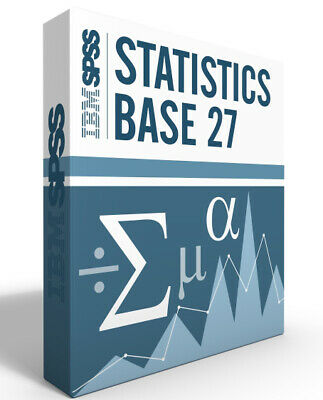SPSS Statistics Grad Pack 27.0 Base Windows or Mac 12 month License
$47.51 (-40%)
Description
You may install the software on up to two (2) computers.
License is good for 12 months. If needed you can order another copy
when yours has expired. Runs on Windows and Mac OS.
Shipping: ships out next business day after you place your order
Why buy from us?
Available for immediate download. Just message us after you place your order.
Buy with confidence from a company with 18 years of experience, and 12 years as a trusted seller on Ebay. See our “Me” profile for more information.
You can always call us with any questions. Don’t buy from a seller who won’t take your calls. Just message us for our toll free number.
We are Top Rated Plus thanks to great customer service.
Don’t get burned by counterfeiters who claim they are selling legitimate products.
Includes:
IBM SPSS Base 27 12 month license
No limitation on the number of variables or cases
Be sure you have all the ad-ons needed for your course or dissertation! Consider the GradPack Premium or GradPack Standard.
IBM SPSS Base Overview, Features and Benefits
IBM® SPSS® Statistics Base is easy to use and forms the foundation for many types of statistical analyses.
The procedures
within IBM SPSS Statistics Base will enable you to get a quick look at
your data, formulate hypotheses for additional testing, and then carry
out a number of statistical and analytic procedures to help clarify
relationships between variables, create clusters, identify trends and
make predictions.
Quickly access and analyze massive datasets
Easily prepare and manage your data for analysis
Analyze data with a comprehensive range of statistical procedures
Easily build charts with sophisticated reporting capabilities
Discover new insights in your data with tables, graphs, cubes and pivoting technology
Quickly build dialog boxes or let advanced users create
customized dialog boxes that make your organization’s analyses easier
and more efficient
Descriptive Statistics
Crosstabulations
– Counts, percentages, residuals,
marginals, tests of independence, test of linear association, measure of
linear association, ordinal data measures, nominal by interval
measures, measure of agreement, relative risk estimates for case control
and cohort studies.
Frequencies
– Counts, percentages, valid and cumulative percentages; central tendency, dispersion, distribution and percentile values.
Descriptives
– Central tendency, dispersion, distribution and Z scores.
Descriptive ratio statistics
– Coefficient of dispersion, coefficient of variation, price-related differential and average absolute deviance.
Compare means
– Choose whether to use harmonic or
geometric means; test linearity; compare via independent sample
statistics, paired sample statistics or one-sample t test.
ANOVA and ANCOVA
– Conduct contrast, range and post
hoc tests; analyze fixed-effects and random-effects measures; group
descriptive statistics; choose your model based on four types of the
sum-of-squares procedure; perform lack-of-fit tests; choose balanced or
unbalanced design; and analyze covariance with up to 10 methods.
Correlation
– Test for bivariate or partial correlation, or for distances indicating similarity or dissimilarity between measures.
Nonparametric tests
– Chi-square, Binomial, Runs,
one-sample, two independent samples, k-independent samples, two related
samples, k-related samples.
Explore
– Confidence intervals for means; M-estimators; identification of outliers; plotting of findings.
Tests to Predict Numerical Outcomes and Identify Groups:
IBM SPSS Statistics
Base contains procedures for the projects you are working on now and any
new ones to come. You can be confident that you’ll always have the
analytic tools you need to get the job done quickly and effectively.
Factor Analysis
– Used to identify the underlying
variables, or factors, that explain the pattern of correlations within a
set of observed variables. In IBM SPSS Statistics Base, the factor
analysis procedure provides a high degree of flexibility, offering:
Seven methods of factor extraction
Five methods of rotation, including direct oblimin and promax for nonorthogonal rotations
Three methods of computing factor scores. Also, scores can be saved as variables for further analysis
K-means Cluster Analysis
– Used to identify
relatively homogeneous groups of cases based on selected
characteristics, using an algorithm that can handle large numbers of
cases but which requires you to specify the number of clusters. Select
one of two methods for classifying cases, either updating cluster
centers iteratively or classifying only.
Hierarchical Cluster Analysis
– Used to identify
relatively homogeneous groups of cases (or variables) based on selected
characteristics, using an algorithm that starts with each case in a
separate cluster and combines clusters until only one is left. Analyze
raw variables or choose from a variety of standardizing transformations.
Distance or similarity measures are generated by the Proximities
procedure. Statistics are displayed at each stage to help you select the
best solution.
TwoStep Cluster Analysis
– Group observations into
clusters based on nearness criterion, with either categorical or
continuous level data; specify the number of clusters or let the number
be chosen automatically.
Discriminant
– Offers a choice of variable selection
methods, statistics at each step and in a final summary; output is
displayed at each step and/or in final form.
Linear Regression
– Choose from six methods:
backwards elimination, forced entry, forced removal, forward entry,
forward stepwise selection and R2 change/test of significance; produces
numerous descriptive and equation statistics.
Ordinal regression—PLUM
– Choose from seven options
to control the iterative algorithm used for estimation, to specify
numerical tolerance for checking singularity, and to customize output;
five link functions can be used to specify the model.
Nearest Neighbor analysis
– Use for prediction (with
a specified outcome) or for classification (with no outcome specified);
specify the distance metric used to measure the similarity of cases;
and control whether missing values or categorical variables are treated
as valid values.
What’s New in IBM SPSS Base
Faster Processing – runs faster than ever
Automatic Linear Models
– A new family of algorithms
makes it possible for business analysts and analytic professionals to
build powerful linear models in an easy and automated manner.
Syntax Editor
– More than a dozen performance and
ease-of-use enhancements for writing syntax in the syntax editor based
on customer feedback, including tooltip tip displaying the “name,”
improved scrolling, improved indentation of lines, toggle commenting
“on” or “off”, the ability to split the syntax editor window, and many
more.
Default Measurement Level
– When a data file is
opened, a measurement level is automatically assigned so business
analysts can focus on solving their business problem rather than
manually setting the measurement level.
Faster Performance
– Save time when creating reports
that involve large tables or a large number of smaller tables. Creating
pivot tables in the output is now up to 200% times faster than before.
In addition, tables will also take up less memory
With IBM SPSS Statistics Base
you can be confident in your analytic results. This comprehensive
software solution includes a wide range of procedures and tests to solve
your business and research challenges.
System Requirements:
License Term:
12 months
Windows:
Operating system:
Microsoft Windows 8 or higher
Hardware:
Intel® or AMD x86 processor running at 1GHz or higher
Memory: 1GB RAM or more recommended
Minimum free drive space: 800MB***
Operating system:
* Apple® Mac 10.13 or higher
Hardware:
Intel processor (32 and 64 bit)
Memory: 1GB RAM or more recommended
Minimum free drive space: 800MB***

